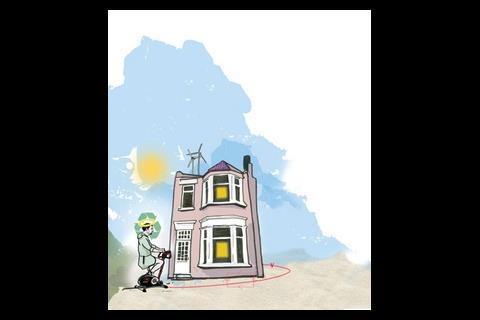ESD’s Steffie Broer reveals how a little lateral thinking – and an eco-concierge – could help reduce carbon emissions in new developments
How can new developments help to meet the ambitious 60% cut the government wants in CO2 emissions by 2050? Try asking a Green Jeeves.
It is becoming incerasingly clear that the scale of the climate change problem is worrying. Tony Blair has revealed that we have only 10-15 years before a tipping point is reached after which catastrophic changes will occur that affect the way we live. Yet as potential solutions to the problem have not as yet measured up, we need radical ideas. Energy for Sustainable Development (ESD) has taken up this challenge in the property development sector.
Whereas conventional wisdom is to apply a top-down approach to property development by using research that asks what we are building and how we can provide energy for buildings, ESD instead has used a people-centred perspective and researched:
- How people are going to live.
- How they impact on the environment.
- How sustainable lifestyles can be made easy.
It is widely agreed that energy consumption and the carbon emissions that go with it are influenced not only by technical efficiency but also by lifestyle and socio-cultural factors. To date, there have been few attempts to combine these factors in models that simulate future energy demand.
Although the consensus on the importance of lifestyles in developing climate change solutions is broad, a gap remains between the perceived importance of lifestyle and socio-cultural factors for carbon emission reductions and quantitative analysis of these factors.
Table 1 splits CO2 emissions into lifestyle categories and indicates the importance of the home compared with areas affected by lifestyle choices such as transport, food and consumables. The figures are based on the average UK lifestyle of a person living in a home built to current Building Regulations.
New research by ESD has taken a holistic view to quantify CO2 emissions in new developments. It has widened the traditional approach of energy-efficient design and covers building energy, transport, food, waste and building materials. It has examined new factors, such as the carbon embodied in the building materials and the ease with which a future resident can live a low-carbon lifestyle. Critically, we evaluated the choices available to developers in terms of both their life cycle costs and their potential carbon savings, which allowed us to rank development options according to the CO2 saved per pound invested.
UK policy frameworks focus largely on energy efficient design and the use of renewable energy. But the carbon impact of transport, consumption and waste – all highly significant – goes largely unrecognised. We hope this research will form a basis for formulating future climate change policy.
Research findings
To meet the carbon target we must identify areas where we can cut emissions with as little effort and expense as possible. Developers are under increasing pressure to ensure their designs minimise resource use and carbon emissions. ESD is identifying other opportunities that can benefit them in a number of ways, such as lowering capital investment, adding greater value to the residents and providing an opportunity for more positive publicity.
The challenge is to design attractive, low-impact buildings that make residents want to live a sustainable lifestyle. Some of the largest and most cost-effective ways of cutting CO2 emissions can be found outside the building, so to speak. The key finding is that investment in the way residents travel and what they eat can show the greatest return. Table 2 (below) displays the amount of CO2 that various “eco-development” options can save.
Ask Green Jeeves
Altering the role of the developer may lead to a decrease in a site’s carbon footprint beyond what may be achieved through meeting standards such as the EcoHomes Excellence criteria.
The biggest challenge is to influence residents to take up the sustainable option, for example in the form of eating locally sourced food. Even the most technologically advanced developments will have little effect on an “eco-slob”. Pioneering developers are employing lifestyle officers, who are in effect eco-concierges who remove the headache created by choosing the sustainable option, for example by running a car club.
Installing a resident Green Jeeves can cost a fraction of conventional approaches. In a case study of the development of 2000 homes that uses a lifestyle officer to promote low-carbon living, the carbon savings were five to 100 times greater than if the same money was invested in an onsite renewable energy source.
A climate of opportunity?
How does a people-centric perspective in addressing the climate change problem benefit property developers?
- It allows quantifiable value to be added for residents. They get, lower bills and healthier homes, for example, and safer, cycling-friendly streets and increased community provisions.
- It reduces the costs of meeting environmental and climate-change targets.
- It helps to gain planning permission by demonstrating reductions in carbon emissions, say, and creating “great neighbourhoods”.
- It creates the powerful marketing tool that is lifestyle communication. Some developments have a resource centre and community website to encourage sustainable behaviours and attract media attention.
- It positions developers as first-movers who respond to a growing societal need. This improves a developer’s reputation.
- It may enable developers to charge a premium for homes. Evidence is increasing that UK citizens are willing to pay more for living in a sustainable home and community.
ESD is advising developer Crest Nicholson on the Bath Western Riverside development of 2,400 homes, a health centre and commercial space. Among other sustainability features, the proposed development includes a sustainable living centre and lifestyle officer, a community website with information on sustainable living and local events and a commitment to the monitoring of site carbon emissions and continuous improvements. As Debbie Aplin, managing director, regeneration, Crest Nicholson, explains, “The main objectives for the sustainable development strategy is to ensure sustainability measures are embedded in the development and that sustainable lifestyle choices are easy for residents to make.”
A lifestyle approach to building developments links climate change and wellbeing and brings social and economic considerations into the debate. Making developments easy and desirable to live in lets people improve their lifestyles and reduce emissions. It is a way to add value for the residents, the developer and the global environment alike.
Source
Building Sustainable Design
Postscript
Steffie Broer is a consultant at Energy for Sustainable Development, which advises developers and local authorities on designing and running eco-developments. Visit www.esd.co.uk or email steffie@esd.co.uk























No comments yet